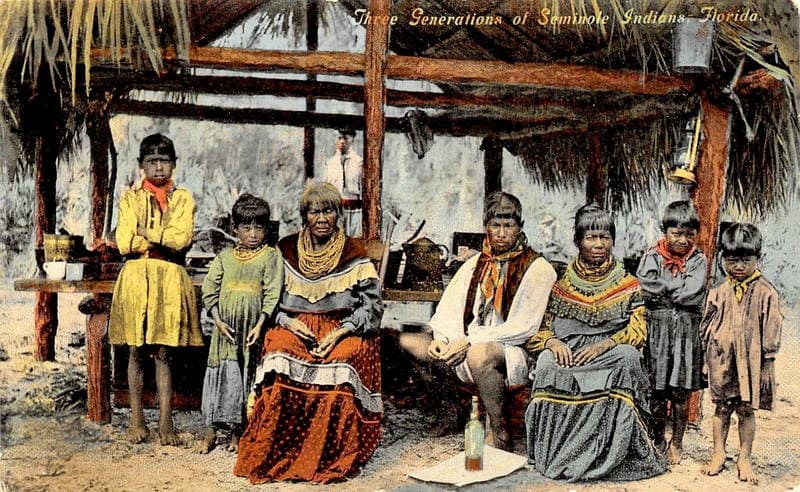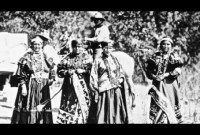
The Unconquered Spirit: How Florida’s Seminole Tribe Forged a Unique Legacy
HOLLYWOOD, Florida – Amidst the glittering lights and bustling energy of a Hard Rock Casino, it’s easy to overlook the profound history that underpins the economic powerhouse of the Seminole Tribe of Florida. Yet, beneath the veneer of modern success lies a story of unparalleled resilience, defiance, and a refusal to be extinguished – a narrative unlike any other in Native American history. The Seminole, often called the "Unconquered People," never signed a peace treaty with the United States, a unique distinction that speaks volumes about their enduring spirit.
From their origins as a diverse collective of Creek, Hitchiti, and other Southeastern Native Americans, along with a significant number of runaway slaves (Maroons), the Seminole forged a distinct identity in the wilds of Florida. The very name "Seminole" is derived from the Muscogee word simanó-li, meaning "runaway" or "wild one," a moniker that perfectly encapsulates their independent and defiant character.

Forging an Identity in the Swamps
By the late 18th century, Florida was a shifting geopolitical landscape, controlled by Spain, then Britain, then back to Spain. This fluidity allowed the nascent Seminole community to thrive, developing a unique culture adapted to the subtropical environment. They built villages, cultivated crops, and hunted the abundant wildlife, often living in harmony with their natural surroundings. Their alliance with Maroons, who sought freedom from slavery, was particularly significant, leading to a vibrant multi-ethnic society that often fought side-by-side against encroaching forces.
The arrival of the United States on Florida’s borders in the early 19th century shattered this relative peace. Driven by the doctrine of Manifest Destiny and the desire for more land for cotton plantations, American forces, led by figures like Andrew Jackson, launched aggressive campaigns against the Seminole and their Maroon allies. These were the First Seminole War (1816-1819) and the Second Seminole War (1835-1842) – the latter being the longest and most costly Indian war in U.S. history.
The Wars and the Unconquered Spirit
The Second Seminole War, in particular, cemented the Seminole’s legendary status. Faced with a vastly superior military force, the Seminole and their allies employed brilliant guerrilla tactics, utilizing the dense, unforgiving landscape of the Everglades as their sanctuary and weapon. They knew the swamps intimately – the hidden trails, the cypress domes, the sawgrass plains – and used this knowledge to ambush American troops, then vanish without a trace.
At the heart of this resistance was Osceola, a young, charismatic war leader who became an iconic symbol of Seminole defiance. Though not a chief by birth, his eloquence and unyielding opposition to removal galvanized the Seminole. In one legendary act of defiance in 1835, when presented with a treaty demanding Seminole removal to Indian Territory (present-day Oklahoma), Osceola famously plunged his dagger through the document, declaring, "This is the only treaty I will ever sign!"
The war raged for seven grueling years, costing the U.S. government an estimated $20 million (an astronomical sum at the time) and thousands of lives. Despite overwhelming odds, the Seminole refused to surrender. Even after Osceola’s capture under a flag of truce – a betrayal that remains a stain on American history – pockets of resistance continued. Many Seminole warriors, along with their families and Maroon allies, simply retreated deeper into the Everglades, becoming even more isolated but steadfast in their determination to remain on their ancestral lands.
"They never surrendered, they just kept moving deeper into the swamps," explains Willie Johns, a former Seminole Tribal Council member. "That’s why we say we’re the unconquered. We never signed a treaty. We stayed here."

This enduring defiance meant that while other Southeastern tribes like the Cherokee, Choctaw, and Creek were forcibly removed along the infamous Trail of Tears, a core group of Seminole remained in Florida. Numbering only a few hundred by the turn of the 20th century, they lived a largely subsistence lifestyle, maintaining their traditions, language (Creek and Mikasuki), and unique chickee-style homes in the remote corners of the Everglades. They survived by hunting, fishing, and crafting, occasionally trading with outsiders for essentials.
From Isolation to Innovation: The Rise of Gaming
For decades, the Seminole remained largely isolated, their existence a testament to their ancestors’ unwavering will. Poverty was widespread, and opportunities were scarce. However, the mid-20th century brought gradual changes. Federal recognition in 1957, establishing the Seminole Tribe of Florida, provided a framework for self-governance and access to federal programs, though economic conditions remained challenging.
The true turning point came in 1979. In a bold and unprecedented move, the Seminole Tribe of Florida opened the first high-stakes bingo hall on their Hollywood reservation. At the time, such operations were illegal under state law. The Tribe argued that as a sovereign nation, they were not subject to state gaming regulations. This audacious act ignited a legal firestorm that would ultimately reshape the landscape of Native American economic development.
The Seminole’s legal battle, though not the specific case that went to the Supreme Court (that was California v. Cabazon Band of Mission Indians in 1987), laid the groundwork for the landmark ruling that affirmed tribal sovereignty over gaming on reservation lands. It established the principle that if a state allowed any form of gambling (like state lotteries or horse racing), it could not prohibit tribes from operating similar gaming enterprises. This opened the floodgates for tribal casinos across the nation.
"We were poor. We had nothing. We had to do something," remembers Howard Tommie, a former tribal chairman instrumental in the bingo hall’s opening. "We took a chance, and it paid off. It changed everything for us."
Indeed, it did. The bingo hall evolved into full-fledged casinos, and the Seminole Tribe rapidly became a leader in the tribal gaming industry. Their success was not just about revenue; it was about reclaiming economic self-determination, a powerful extension of their historical fight for sovereignty.
Global Reach and Cultural Preservation
The pinnacle of their economic ascent came in 2007 when the Seminole Tribe of Florida made global headlines by acquiring Hard Rock International for $965 million. This unprecedented move made them the first Native American tribe to own a major international hospitality company, operating hotels, casinos, and cafes in dozens of countries worldwide.
This acquisition wasn’t just a business deal; it was a profound statement. The descendants of a few hundred individuals who refused to surrender, surviving in the Everglades on their own terms, were now global players, managing a multi-billion-dollar enterprise. The "unconquered" spirit had found a new battlefield – the global marketplace – and once again emerged victorious.
Today, the Seminole Tribe of Florida uses its vast resources to benefit its members and preserve its unique heritage. Revenue from gaming and other enterprises funds education, healthcare, housing, and infrastructure on their reservations. Cultural programs teach the younger generation the traditional languages, crafts, and ceremonies that almost vanished during their years of isolation. The Ah-Tah-Thi-Ki Museum, located on the Big Cypress Reservation, stands as a testament to their past, meticulously preserving artifacts and stories.
"We have to remember where we came from," says Marcellus Osceola Jr., the current Chairman of the Seminole Tribe of Florida, emphasizing the balance between modernity and tradition. "The money helps us do that. It allows us to preserve our culture, teach our children, and make sure our history is never forgotten."
A Legacy for the Future
The Seminole Tribe of Florida’s journey from a defiant band of "runaways" to an economic and cultural force is a powerful narrative of resilience and adaptability. Their history is not just about survival; it is about triumph in the face of overwhelming odds, a testament to the enduring strength of a people who, against all expectations, refused to be conquered.
Their unique legacy – etched in the very fact that no peace treaty bears their signature – serves as a beacon of inspiration, demonstrating that true sovereignty is not merely a legal status, but a fiercely protected spirit that can shape destinies and redefine what it means to be a "wild one" in the modern world. The Seminole story is a vibrant, living testament to the power of perseverance, a narrative that continues to unfold with each passing generation.


